Key takeaways:
- Urban wildlife corridors enhance biodiversity by providing safe passage for animals, connecting fragmented habitats, and promoting ecological resilience.
- Community involvement in planning fosters a sense of ownership and leads to innovative, culturally relevant designs that reflect local values.
- Effective corridor design includes principles such as width, natural elements, permeability, and regular monitoring to adapt to wildlife needs.
- Successful case studies like the Wildlife Crossing at Banff and the Los Angeles River Revitalization demonstrate the positive impact of urban corridors on both wildlife and community engagement.
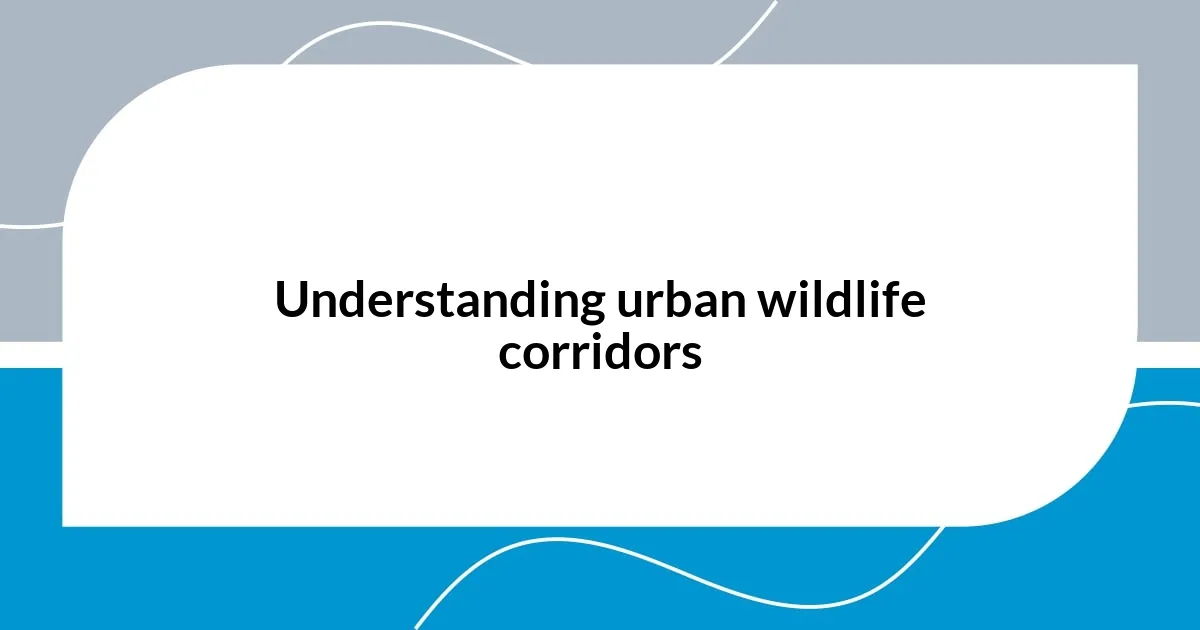
Understanding urban wildlife corridors
Urban wildlife corridors are vital lifelines for various species navigating the concrete jungles we call cities. I’ve often wondered, how many animals cross our paths daily without us even noticing? These corridors, whether they’re green bridges or narrow park pathways, provide safe passage for wildlife, helping them find food, shelter, and mates while reducing the risk of accidents.
During a recent hike in my city, I stumbled upon a beautifully designed corridor that connected two fragmented habitats. Seeing a family of deer gracefully traverse this pathway filled me with wonder and hope. It’s fascinating how these networks encourage biodiversity, allowing species to thrive even amid urbanization. But it makes me think: what happens to the animals that don’t have these corridors?
As I delve deeper into the significance of urban wildlife corridors, I can’t help but feel a sense of responsibility. These structures not only benefit wildlife but also enhance our own lives by preserving nature’s beauty. Imagine relaxing in a park and witnessing bird species flit about, reminders of the vibrant ecosystem we often overlook. It’s this connection that prompts me to advocate for more thoughtful urban planning that respects and incorporates wildlife needs.
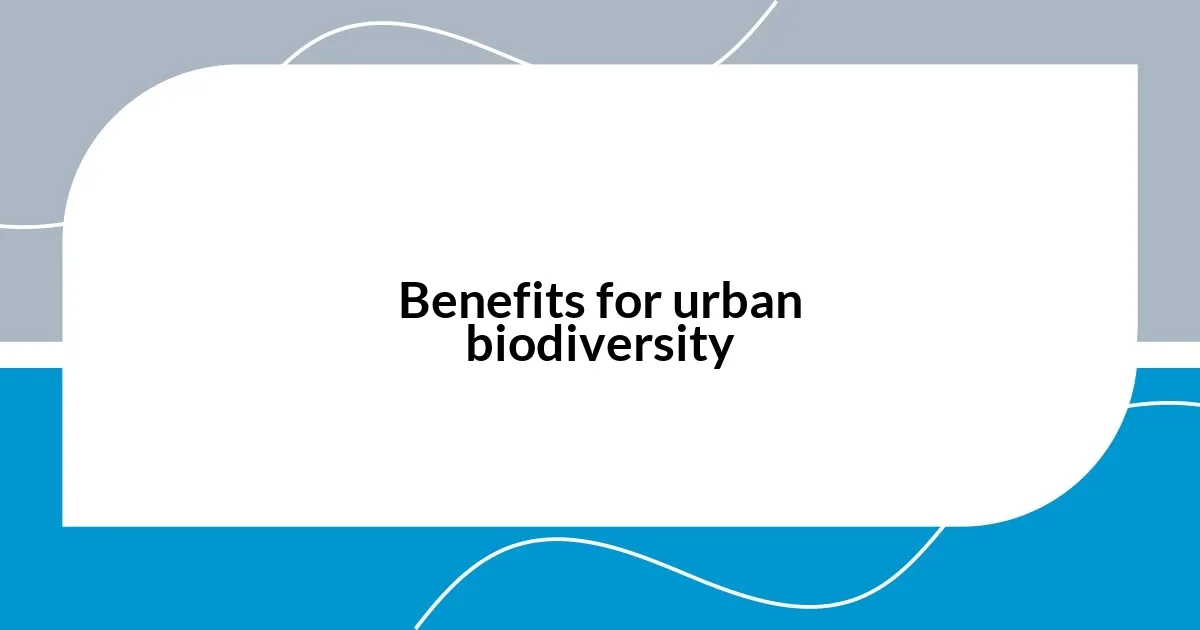
Benefits for urban biodiversity
Urban biodiversity flourishes when wildlife corridors are established, creating a tapestry of interconnected habitats. Just last year, I volunteered for a city project that transformed an abandoned lot into a green corridor. The joy I felt watching the resurgence of local bird species was truly captivating. Each song I heard became a testament to the way urban spaces can rejuvenate ecosystems.
I’ve also noticed how these corridors serve as excellent educational opportunities for city dwellers. While visiting a family-friendly nature walk, I overheard children excitedly sharing facts about the native species they spotted. It’s a reminder that connecting with nature fosters appreciation and stewardship among future generations. Isn’t it comforting to think that these simple pathways can spark curiosity about our environment?
Moreover, urban wildlife corridors play a crucial role in mitigating climate change effects. During a community meeting where we discussed the project plans, the shared concern about rising temperatures resonated with everyone. It was exciting to realize we weren’t just creating paths for animals; we were also helping to cool our urban heat islands and improving air quality for ourselves. Imagine the collective impact if more cities embraced this initiative!
| Aspect | Benefits |
|---|---|
| Habitat Connectivity | Allows species to move freely and access essential resources. |
| Biodiversity Preservation | Encourages the growth of diverse flora and fauna, enhancing resilience. |
| Educational Opportunities | Provides a platform for public engagement and awareness about local wildlife. |
| Climate Regulation | Helps in lowering urban temperatures and improving overall air quality. |
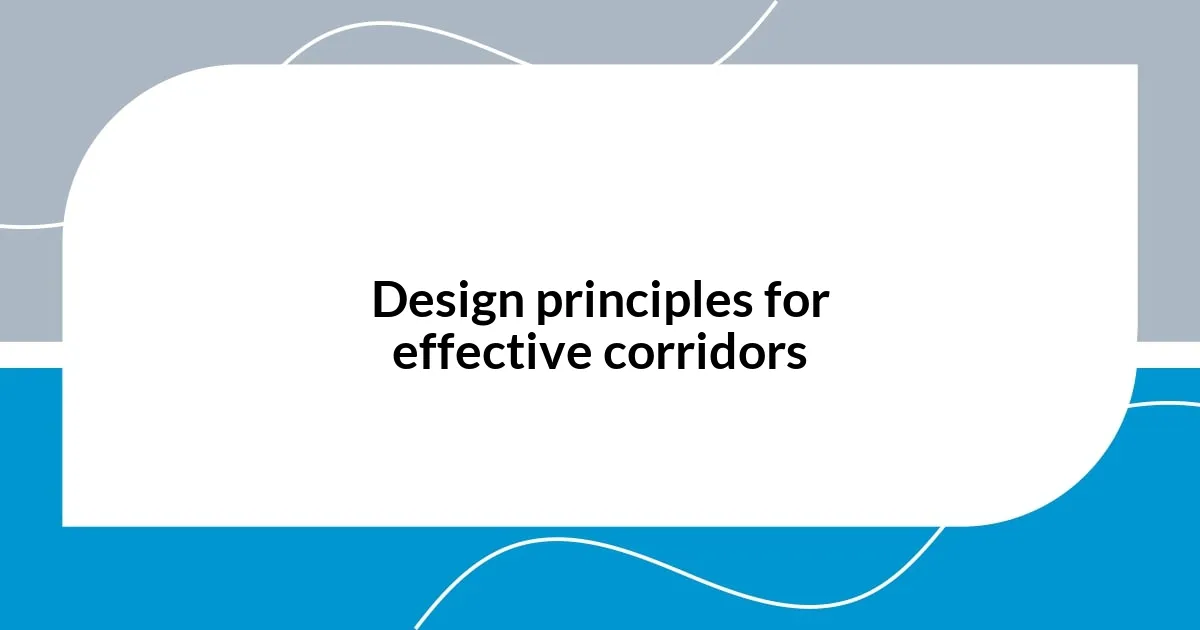
Design principles for effective corridors
Designing effective urban wildlife corridors requires a thoughtful approach to ensure that they truly serve their purpose. I recall visiting a city where the corridors not only included native plants but also specific features that catered to the wildlife’s needs, such as water sources and proper shelter. Seeing small animals utilize these safe spaces reminded me of how critical it is to prioritize native biodiversity in design.
Here are key principles for creating effective wildlife corridors:
- Width and Connectivity: Corridors should be wide enough to accommodate various species and link significant habitats seamlessly, minimizing wildlife exposure to urban challenges.
- Natural Elements: Incorporating native vegetation and natural barriers can help wildlife feel secure and encourage their presence.
- Permeability: Designing gaps or “stepping stones” that allow small animals to navigate urban landscapes enhances mobility and safety.
- Monitoring and Adaptation: Regular assessments of corridor usage can inform adjustments, ensuring they adapt to changing wildlife needs over time.
- Public Involvement: Engaging the community in the planning process can lead to greater awareness and investment in local wildlife, fostering a shared sense of responsibility.
I genuinely believe that when design incorporates these principles, it transforms not just wildlife habitats but also enriches the human experience in urban settings. It’s like creating a hidden world of wonder right under our noses, breathing life into our concrete surroundings.
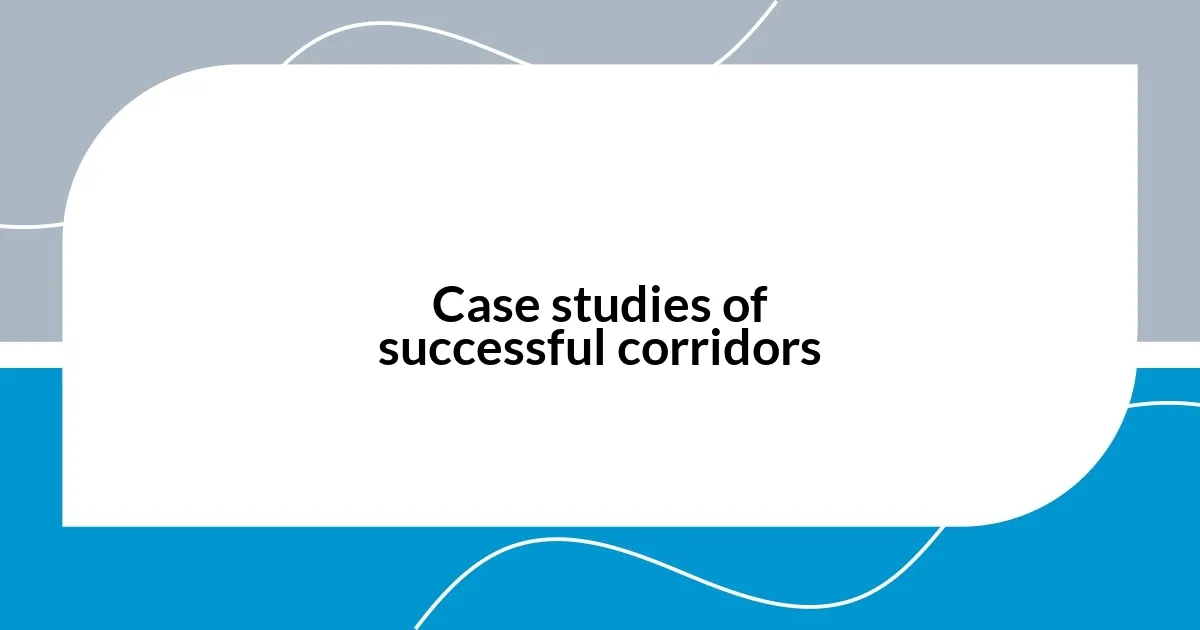
Case studies of successful corridors
One of the most inspiring case studies I’ve come across is the Wildlife Crossing at Banff National Park in Canada. This remarkable structure enables animals to safely cross the Trans-Canada Highway, reducing wildlife-vehicle collisions significantly. During my visit, I was struck by the sight of elk confidently traversing the bridge, a clear demonstration of how targeted design can harmonize human infrastructure with nature. Isn’t it fascinating how we can create spaces that allow both people and wildlife to share the same land safely?
In another instance, the Los Angeles River Revitalization project has done wonders for urban wildlife. What began as a concrete channel has slowly transformed into a vibrant corridor teeming with life. Walking along the riverbanks, I couldn’t help but notice the increase in bird species, which seemed to thrive in the newly restored habitats. Seeing families and children enjoying these areas made me consider how urban wildlife corridors can connect communities to their natural environments. Don’t you think there’s something magical about witnessing nature reclaiming urban spaces?
Lastly, the Chicago Riverwalk serves as a prime example of how urban corridors can enhance both ecology and community spaces. I remember sitting by the water, watching native fish swim freely in cleaner waters as city dwellers enjoyed leisurely strolls. It’s a heartwarming reminder of how integrating wildlife corridors into urban designs not only benefits wildlife but also enriches our urban experiences. How often do we get to enjoy nature while navigating our bustling streets? It feels like the best of both worlds!
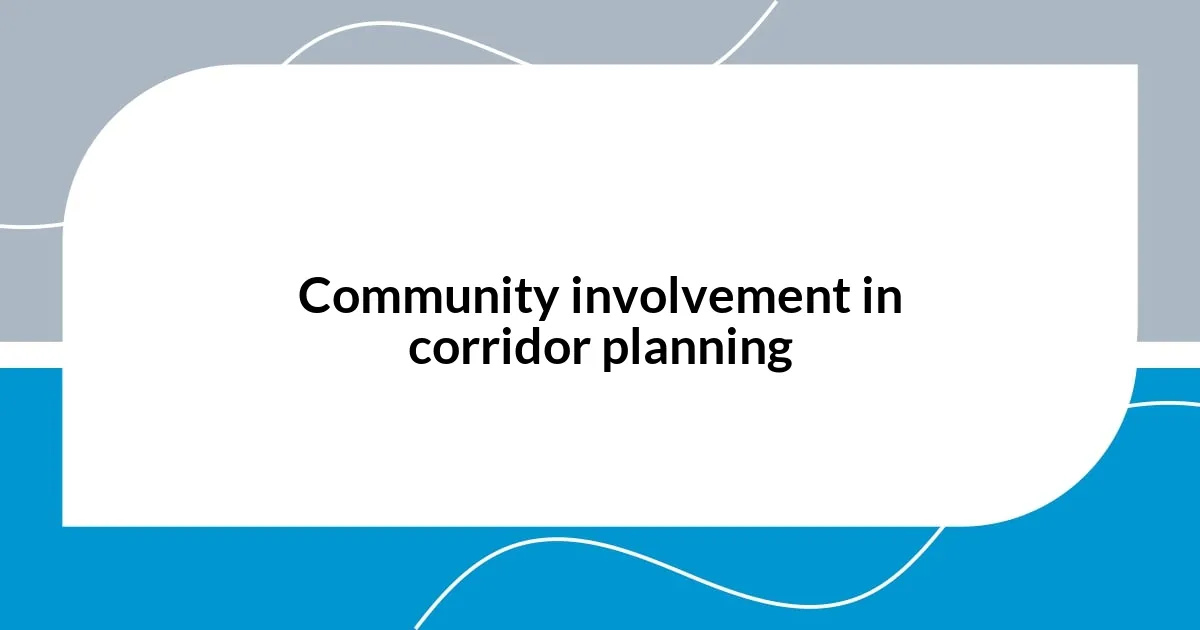
Community involvement in corridor planning
Engaging the community in corridor planning is essential for the success and sustainability of these projects. I remember attending a local meeting where residents passionately discussed their concerns about wildlife habitats being disrupted by urban expansion. Their insights brought to light the unique cultural and ecological perspectives that often get overlooked in policy discussions. Isn’t it amazing how a simple conversation can spark so much awareness?
When community members are involved, they not only voice their needs but also develop a deeper connection to the wildlife that frequents their neighborhoods. I recall when my community came together to plant native species along a nearby stream. The sense of pride and ownership was palpable, and I could see how the excitement of enhancing our environment overwhelmed hesitation. What if more city planners tapped into this community spirit?
A collaborative approach to corridor design often leads to innovative solutions. One successful workshop I attended featured local artists, schools, and wildlife enthusiasts brainstorming ideas to make corridors more visually appealing and functional. This diversity of thoughts sparked creativity, resulting in designs that reflected our unique identity and respect for nature. How powerful it is to see our community’s values reflected in urban spaces!
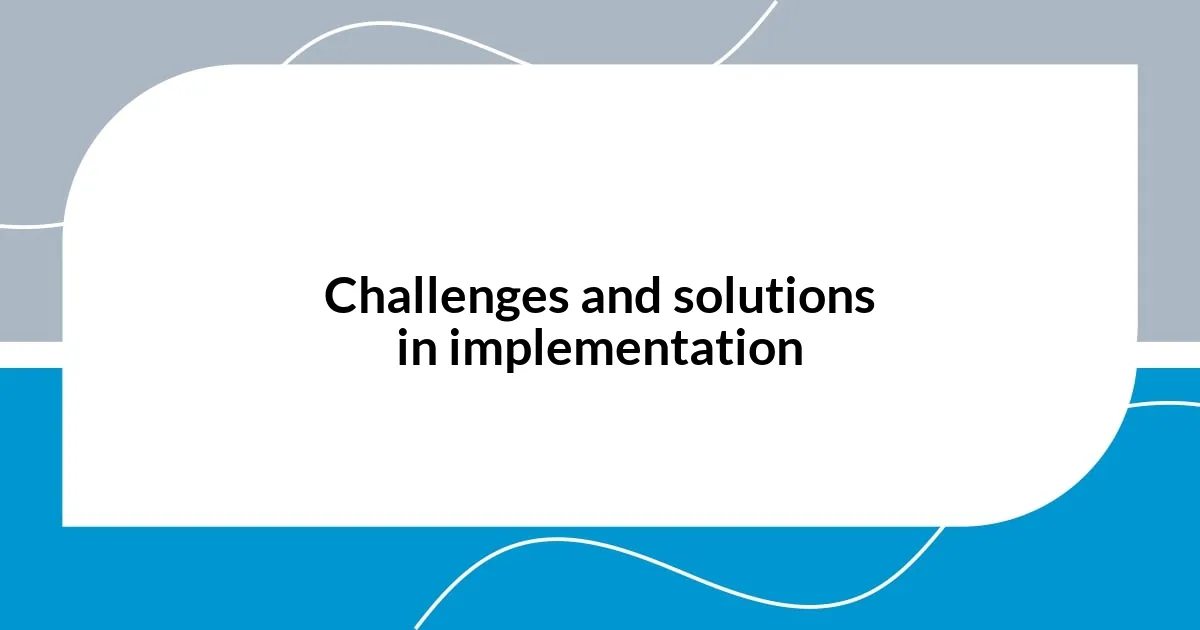
Challenges and solutions in implementation
Implementing urban wildlife corridors is not without its hurdles. One challenge I often see is the resistance from local businesses and residents who worry about potential disruptions. I remember a town hall meeting where a passionate business owner voiced her fears about losing foot traffic due to the construction of a corridor. It struck me how critical it is to balance environmental needs with economic concerns. How can we ensure that wildlife corridors are developed without alienating those who rely on the land for their livelihoods?
Funding is another significant roadblock. Many projects linger in limbo due to budget constraints. In a workshop I attended, participants discussed the importance of creative funding sources, like public-private partnerships and community grants. It’s fascinating how modern crowdfunding platforms can rally community support for these initiatives. Could this be a turning point for some communities that have felt sidelined in conservation efforts?
Lastly, coordinating efforts across various stakeholders can be complex. I remember a project proposal in my neighborhood that aimed to connect two parks but stalled due to differing priorities among local authorities. This situation prompted a realization for me: having a unified vision is key. Why don’t we create a task force that brings everyone—government officials, local ecologists, and community members—together early in the planning process? A collaborative framework could pave the way for smoother implementation of these vital wildlife corridors.